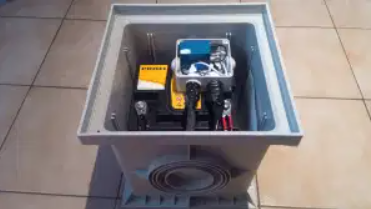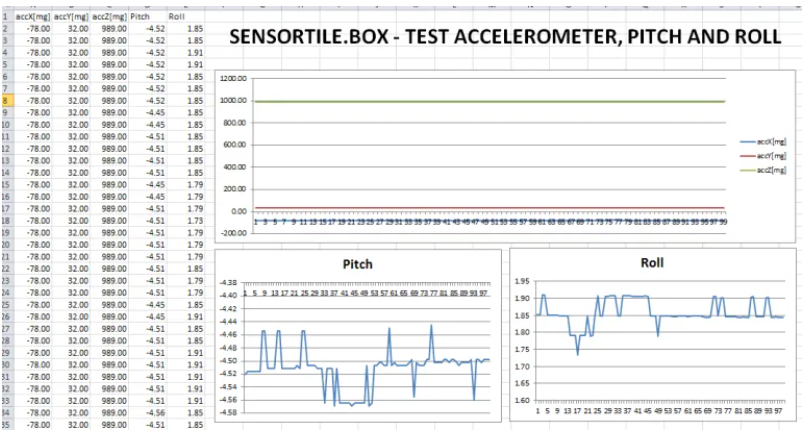This article is compiled from STMicroelectronics blog
Sicily has become the site of a groundbreaking experiment for STMicroelectronics (ST), using a new “smart” technology to detect earthquakes, underground structures and volcanic activity in advance.
Thanks to Rosario Catania (ST engineer) for his passion for technology and Etna, and Alessandro Bonforte, researcher at INGV (National Institute of Geophysics and Volcanology), for his valuable support in monitoring Etna activity with the SensorTile.box.

Why Etna?
Mount Etna is an active volcano on the east coast of Sicily, located between the edges of the African and Eurasian plates. It is the highest active volcano in Europe outside the Caucasus, and the highest peak south of the Italian Alps, with a current height of 3,326 metres (10,912 ft). Etna covers an area of 1,190 square kilometres (459 sq mi) and has a circumference of 140 kilometres (87 mi). This makes it the largest of Italy's three active volcanoes, about 2.5 times higher than Mount Vesuvius.
Etna is one of the most active volcanoes in the world and has been active in recent years. The fertile volcanic soil supports extensive agriculture, with vineyards and orchards scattered around the lower slopes and the vast Catania Plain in the south. Due to Etna's recent history of activity and the nearby population, it has been designated as one of the ten most dangerous volcanoes by the United Nations. In June 2013, it was listed as a World Heritage Site by UNESCO.
The Pernicana belt is an important area on Mount Etna because it experiences fault displacements of around 2 centimeters per year. Today, the distance between the two sides of the fault is around 50 to 60 meters, and the annual displacements result in frequent earthquakes. It is a perfect testing ground to evaluate the effectiveness of new sensor technologies with the resolution and accuracy required to monitor this activity.
ST's research in Sicily and Catania further confirmed that the region is best suited for monitoring ground movements and vibrations caused by volcanoes.
Rosario Catania and the Beginning of the Experiment
Rosario Catania is an ST employee who lives in Sicily and spends most of his free time hiking, observing and studying the Etna volcano. Rosario Catania and Alessandro Bonforte are also members of the ERO (Etna Radio Observatory) group. Rosario said: "This group was formed about ten years ago, mainly to detect natural radio signals from the Etna volcano. When my friend and colleague Alesandro Longo developed a very low frequency radio, I also became interested in amateur radio technology and decided to get an amateur radio license and buy a set of tools to detect radio signals from the volcano. Wireless allows me to feel the "heartbeat" of the terrain, but only when the signal is not interfered with by humans."
Rosario is the Guinness World Record holder for the Nordic marathon walking course, having walked for 70 hours straight in Sicily and Mount Etna, breaking the previous record of 68 hours.
Rosario's passion for Etna and the technical knowledge he had acquired over the years at ST inspired him to collaborate with Alessandro Bonforte to start experiments on Mount Etna to identify, monitor and study its movements. They discovered that the SensorTile.Box was the ideal device to detect the parameters needed to detect the movements and vibrations of the volcano.
experiment
Rosario and Alessandro are looking for vibration, displacement and acceleration data associated with the terrain near the volcano, which requires the use of micro-electro-mechanical systems (MEMS) sensors such as accelerometers and gyroscopes, as well as complex algorithms running on an in-house microcontroller to analyze this information. Another important aspect of the experiment is the overall cost of the analysis setup. Specialized equipment for similar tasks can be very expensive, and it is important to ensure that it does not get lost or damaged, which is why it has never been used in areas such as the Pernicana belt.
The STEVAL-MKSBOX1V1, or SensorTile.Box, is the perfect solution. This ready-to-use kit with a wireless IoT and wearable sensor platform is designed to help developers build and deploy applications based on remote motion and environmental sensor data, even if they are not experts in sensor-based technology.

In addition to costing significantly less than traditional devices, the SensorTile.Box offers further advantages, such as combining all the required smart sensors in a single product, with an integrated microcontroller capable of processing, interpolating and exporting data for further analysis. All of this greatly simplifies the task of confirming and analyzing recorded motion and vibration events. All SensorTile.Box devices are low power, and the system has clever power management logic that keeps it dormant until an appropriate event is detected, meaning it can record weeks of activity on a coin cell battery.
The experiment started on August 4, 2020. The SensorTile.Box, configured as an inclinometer and another vibrometer, together with a car battery and connectors, was placed in a watertight container and buried in an underground well in the Pernicana belt. In order to collect enough data for the study, the instrument will continue to track all movements over the next few months, for a year. During the first few months, the SensorTile.Box will be calibrated frequently to increase sensitivity and optimize battery and data transmission processing.

future
The SensorTile.Box has been installed at an altitude of 1,500 meters on the south side of the volcano, in parallel with a traditional nanosensor system, enabling accuracy comparisons to be made and the SensorTile.Box to be fine-tuned for optimal performance.
As Rosario Catania says, "The challenge is to understand whether these techniques can detect small ground movements, in areas of high seismic and volcanic hazard, where conventional equipment is difficult to use and often too expensive to sacrifice for experimental purposes."
A third SensorTile.Box will be installed in the Bronte area west of Etna by the end of this year.
If this first experiment is successful, the next steps will involve deployment to more dangerous and active areas in order to collect more data and gain a deeper understanding of how to predict volcanic eruptions.
Previous article:How low power and energy harvesting technologies can make the IoT greener
Next article:Bluetooth + DALI - the real spring of IoT lighting has arrived
- Popular Resources
- Popular amplifiers
- e-Network Community and NXP launch Smart Space Building Automation Challenge
- The Internet of Things helps electric vehicle charging facilities move into the future
- Nordic Semiconductor Launches nRF54L15, nRF54L10 and nRF54L05 Next Generation Wireless SoCs
- Face detection based on camera capture video in OPENCV - Mir NXP i.MX93 development board
- The UK tests drones equipped with nervous systems: no need to frequently land for inspection
- The power of ultra-wideband: reshaping the automotive, mobile and industrial IoT experience
- STMicroelectronics launches highly adaptable and easy-to-connect dual-radio IoT module for metering and asset tracking applications
- This year, the number of IoT connections in my country is expected to exceed 3 billion
- Infineon Technologies SECORA™ Pay Bio Enhances Convenience and Trust in Contactless Biometric Payments
- LED chemical incompatibility test to see which chemicals LEDs can be used with
- Application of ARM9 hardware coprocessor on WinCE embedded motherboard
- What are the key points for selecting rotor flowmeter?
- LM317 high power charger circuit
- A brief analysis of Embest's application and development of embedded medical devices
- Single-phase RC protection circuit
- stm32 PVD programmable voltage monitor
- Introduction and measurement of edge trigger and level trigger of 51 single chip microcomputer
- Improved design of Linux system software shell protection technology
- What to do if the ABB robot protection device stops
- CGD and Qorvo to jointly revolutionize motor control solutions
- CGD and Qorvo to jointly revolutionize motor control solutions
- Keysight Technologies FieldFox handheld analyzer with VDI spread spectrum module to achieve millimeter wave analysis function
- Infineon's PASCO2V15 XENSIV PAS CO2 5V Sensor Now Available at Mouser for Accurate CO2 Level Measurement
- Advanced gameplay, Harting takes your PCB board connection to a new level!
- Advanced gameplay, Harting takes your PCB board connection to a new level!
- A new chapter in Great Wall Motors R&D: solid-state battery technology leads the future
- Naxin Micro provides full-scenario GaN driver IC solutions
- Interpreting Huawei’s new solid-state battery patent, will it challenge CATL in 2030?
- Are pure electric/plug-in hybrid vehicles going crazy? A Chinese company has launched the world's first -40℃ dischargeable hybrid battery that is not afraid of cold
- The diameter of the four holes on the EK140 base plate
- This circuit is called a "lawn mower"
- CC3200-LAUNCHXL
- How to monitor battery voltage with Arduino
- Image Algorithm Transplantation to DSP and Its Optimization Steps
- Prize-winning live broadcast: Keysight’s Metaverse Test Series Seminar: Challenges in VR/AR Digital Interface Testing in Progress!
- 51 STM32 reference study manuals, one-click download without points!
- Microwave and RF Applications
- [ESP32-S2-Kaluga-1 Review] 3. Physical buttons?
- Unable to search for Bluetooth signal after adding characteristic value

 LM1281N
LM1281N
















 京公网安备 11010802033920号
京公网安备 11010802033920号